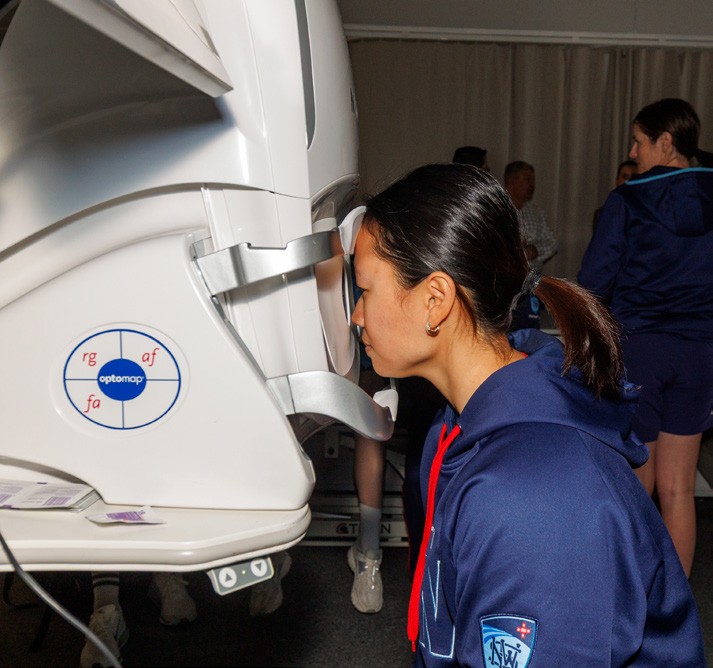Optimising Vision for Cricketers’ Performance

NSW cricketer Elsa Hunter, being tested.
A mass vision screening programme, hosted by Cricket NSW, has revealed “supernormal” vision among elite cricketing participants, as well as a range of eye conditions requiring urgent treatment.
The vision clinic is in its second year and has expanded its scope beyond the initial focus on ultraviolet (UV) damage to the eye to incorporate high-level visual performance metrics, including aberrometry, topography, dynamic tear film break-up, and glare and lowcontrast vision testing, to better assess how vision affects elite athletic performance.
Held at Cricket NSW headquarters in Sydney in late June, 32 male and female NSW and Australian cricketers were subjected to a battery of eye tests by a team of technicians and orthoptists, led by ophthalmologists Dr Shanel Sharma and Dr Daya Sharma.
IMPROVING PERFORMANCE WITH BETTER VISION
Dr Daya Sharma said the clinic’s aim was twofold: “To screen for eye disease that could be relevant and could affect their career later. But second, to look at their visual parameters and see if there is anything we can do to improve their vision with the aim of improving their performance.
“That link is harder to prove because there’s a lot of variables in cricket performance, but obviously we would expect that if you can see better, you’ll bat better, you’ll field better, etc.”
While the testing picked up conditions requiring further treatment, Dr Daya Sharma said it also revealed players with “supernormal” vision (better than 6/6).
“This project has emphasised the importance of supernormal vision for some specific tasks,” said Dr Sharma. “We had an extra chart to test visual acuity (VA) better than 6/3. Many players have VA around this level, with one better than 6/3 unaided.
“If you’re looking at high visual performance, you should be measuring it and trying to target that. And so, the implication is we actually need better equipment to look at high performance vision.”
PERSONAL OPPORTUNITIES
One of the athletes who attended was 20-year-old Elsa Hunter, who plays for the NSW Breakers and the Sydney Sixers. Diagnosed with myopia at age seven, Hunter plays in contact lenses. Off-field she favours spectacles fitted with MiyoSmart lenses.
Hunter was intrigued by the possibility of undergoing laser vision correction in the future – an option that became tangible thanks to the detailed data collected at the screening.
“Being able to see the ball is one of the most important things about my sport. So having the opportunity to have these tests is really cool. Today was really informative.”
Hunter also emphasised how seriously her team takes UV protection. “We spend up to eight hours a day out on the field; we’re very sun safe.”
“Australia is the best country in the world, but the sun provides a tax we all pay...”
CANCERS AROUND THE EYES
But it’s not just about vision. Dermatologist Dr Shivam Kapila, of Burwood Park Dermatology, attended to study skin cancer risks, particularly those affecting the delicate eyelid region. About 5–10% of all skin cancers occur near the eyes.
Cricketers, Dr Kapila said, were high-risk patients playing in a high-risk country.
“Australia is the best country in the world, but the sun provides a tax we all pay – whether it be through skin cancer, photodermatoses, photoaging or UV eye damage.
“It’s important to figure out, are there any predictors or risk factors around eyelid skin that can be justification for pre-emptive screening; that’s really what we’re hoping to achieve here.”
Dr Kapila said he would love to see a more optimised referral pathway between dermatologists, optometrists, and ophthalmologists.
“An early referral can minimise progression, or at least allow early intervention when disease is identified. I think optometrists and ophthalmologists do a great job (referring to dermatology) and hopefully we (dermatologists) do the same, referring back. But if we can smooth out the factors for earlier referral, that’s where multidisciplinary care is really optimised.”